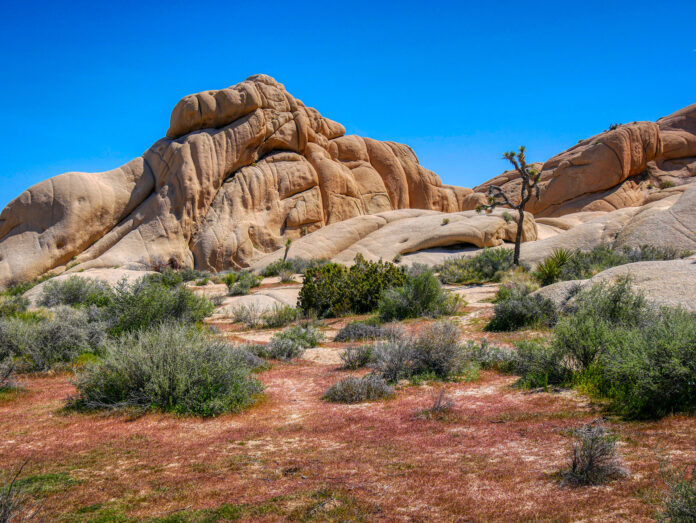The Mojave Desert, named after the indigenous Mojave tribe, spans over 35,000 square kilometers in the southwestern United States, covering parts of Utah, Nevada, Arizona, and California. Natural phenomena, ghost towns, national parks, and unique artifacts draw tourists from around the world. Here are ten fascinating facts about this remarkable desert:
- The Legendary San Andreas Fault: Running through the Mojave is the San Andreas Fault, one of the largest and most active tectonic faults in the world, stretching 1,280 km long and around 16 km deep. Formed by the collision of the Pacific and North American tectonic plates, the fault shifts by about 4 cm annually, causing earthquakes in cities like San Francisco and Los Angeles. One disaster inspired the movie San Andreas. Scientists believe major earthquakes along the fault occur roughly every 150 years.
- Badwater Marathon: Death Valley, part of the Mojave, is one of the hottest places on Earth, with summer temperatures regularly exceeding 50°C (122°F). From June to October, it’s nearly impossible to be in the valley, with insects unable to fly, and lizards lying on their backs to avoid burning their feet. Despite this, the annual Badwater Marathon takes place here, covering 217 km, including mountain terrain. Over a third of participants drop out. In 2000, Russian athletes Anatoly Kruglikov and Irina Reutovich led the race.
- Ghost Town of Calico: The Mojave has abandoned towns founded in the 19th century near precious metal deposits. One such town is Calico, home to over 500 silver mines. By the early 20th century, silver’s value had decreased, leading to the town’s decline. Decades later, businessman Walter Knott bought Calico and turned it into a profitable tourist attraction. Visitors can now experience restored hotels, restaurants, shops, and even take a ride on a small railway that loops through the former mines.
- Joshua Tree Forests: The Mojave is home to the Joshua tree, a unique plant that can live for hundreds of years. Mormon settlers named it after the biblical figure Joshua, as its branches reminded them of his raised arms signaling the capture of a city. These trees, which bloom with cream-colored flowers in the spring, are a signature feature of the desert’s landscape.
- The Desert Phone Booth: Installed in California in the mid-20th century, the phone booth was originally used by workers in the area. When they left, its number remained active. In the 1990s, a man known as “Deuce” called the number and reached a stranger, which sparked the booth’s rise to fame. It even inspired the film Mojave Phone Booth.
- Lake Mead: Lake Mead, the largest reservoir in the United States and a popular recreation spot, is located in the Mojave. It was created by the construction of the Hoover Dam on the Colorado River and named after Elwood Mead, the head of the U.S. Bureau of Reclamation. As the lake levels fluctuate, the ruins of the submerged town of St. Thomas sometimes resurface.
- Mojave Max the Desert Tortoise: Red Rock Canyon National Park is home to the endangered desert tortoise, which has adapted to the harsh desert conditions. Like a camel, it can store water in its body and digs burrows in the sand for shelter. Mojave Max, a male tortoise, has become a symbol of desert conservation and leads the Desert Tortoise Conservation Program.
- The Giant Thermometer: Standing over 12 meters tall, the world’s largest thermometer is located in a small town near Death Valley. It was built by businessman Willis Herron, who had dreamed of creating a giant thermometer since he was young. After being destroyed by a storm, it was restored twice, most recently by his family in 2014. The highest temperature it has ever recorded was 56.6°C (134°F) in 1913.
- Kelso Dunes’ Singing Sand: The Kelso Dunes in Red Rock Canyon produce a deep humming sound as sand cascades down their slopes. This eerie noise, which can last up to 15 minutes and be heard from as far as 10 km away, once frightened locals with its resemblance to “desert spirits.” The sound has been compared to airplane propellers, drumbeats, and bell chimes.
- Airplane Graveyard: The Mojave is home to the world’s largest aircraft boneyard, where retired military and commercial planes are stored. The scorching heat prevents the metal from rusting. Some planes are sold for parts or used in Hollywood films. The area is largely off-limits, but some visitors have managed to negotiate brief tours for photos. Nearby is a site used for space travel, making it the only location in the U.S. offering space tourism flights.
The Mojave Desert, with its rich history, unique natural features, and remarkable man-made attractions, continues to captivate adventurers and researchers alike.
